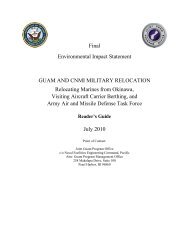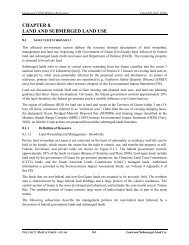CHAPTER 1 - Guam Buildup EIS
CHAPTER 1 - Guam Buildup EIS
CHAPTER 1 - Guam Buildup EIS
Create successful ePaper yourself
Turn your PDF publications into a flip-book with our unique Google optimized e-Paper software.
<strong>Guam</strong> and CNMI Military Relocation Final <strong>EIS</strong> (July 2010)<br />
Father Duenas Memorial School and Statue<br />
<strong>Guam</strong>‘s only all-boy preparatory high school has a statue of Father Jesus Duenas who became a martyr<br />
during World War II.<br />
War in the Pacific National Historic Museum<br />
The description of the Park and its assets on <strong>Guam</strong> and Saipan have been provided by the National Park<br />
Service.<br />
The park's seven units preserve and interpret significant World War II invasion sites and have the most<br />
diverse coral reef system within the National Park System. Submerged resources encompass a portion of a<br />
Marine Protected Area, sunken WWII artifacts, two culturally significant traditional fishing areas, and<br />
habitat for over 3,500 marine species, including over 200 coral species and threatened hawksbill and<br />
green sea turtles. The visitor center is located adjacent to the main gate of Naval Base <strong>Guam</strong> in a facility<br />
leased from the Navy. It houses an exhibit area and theater, a small bookstore, offices for interpretive<br />
staff, and museum collections for both War in the Pacific NHP and American Memorial Park. Individuals<br />
and large tour groups visit the center during its open hours seven days a week, year-round. In 2011, the<br />
center will house new, permanent exhibits that should attract increased visitation and provide more<br />
opportunities for visitors to learn about park resources and values. Parking at visitor center is presently<br />
limited on weekdays when adjacent naval offices are busy.<br />
The park unit at Asan Beach preserves the site of northern landing beach for U.S. forces during the 1944<br />
liberation of <strong>Guam</strong>. In addition to significant historical value, the area also provides a physical setting that<br />
is used for healthful activities such as running, walking, flying kites, and water recreation when<br />
conditions permit. Many people enjoy beach for picnicking and scenery. Often during the year, large<br />
group-sanctioned events are held on the open field. NPS stages ‗Movies in the Park‘ periodically, where<br />
family-oriented and conservation-themed movies draw people into the park for evening activities. This<br />
unit contains marine acreage used for fishing and marine wildlife watching, while divers and snorkelers<br />
are particularly drawn to Marine Preserveand Camel Rock. The area is clearly a focal point for local<br />
community and island visitors alike.<br />
In order to support visitors at this site, a number of facilities are present including parking, restrooms,<br />
trails, picnic tables, and trash receptacles. The facilities are maintained to a high standard to protect the<br />
integrity of resources, and provide quality experience that most peopleexpect and are entitled to.<br />
Similarly, the Agat Unit preserves site of U.S. forces southern landing beach in 1944. In addition, the area<br />
contains marine acreage with popular dive sites, including Hap‘s Reef. Fishing from beach and from sea<br />
by boat is also a popular activity for island residents. This unit, though smaller, contains a variety of<br />
facilities such as restrooms, tables, grills, and trash receptacles. These facilities are found near historic<br />
guns displayed alongside the Japanese fortifications at Ga‘an Point. With these attractions and facilities in<br />
close proximity, multiple uses can be found at this unit, which also includes similar fortifications and<br />
facilities at Apaca Point.<br />
Other park units at War in the Pacific NHP (Piti Guns, Fonte Plateau, Mt. Chachao/Mt. Tenjo, and Mt.<br />
Alifan) are each considerably smaller than Asan Beach and Agat Units, but they contain wartime artifacts<br />
and structures and are attended by interpretive exhibits that draw visitors into drama and horror of what<br />
occurred there. The story is one that appeals to all former wartime antagonists, including the Japanese<br />
who defended <strong>Guam</strong> during occupation and subsequent American assault. The Asan Bay Overlook<br />
(located on a ridge at the top of Asan Inland Unit), is significant in that it memorializes those who died in<br />
conflict while defending <strong>Guam</strong> during the Japanese invasion, who suffered from atrocities of occupation,<br />
VOLUME 9: APPENDICES G-1-6 <strong>EIS</strong> Resource Technical Appendix






